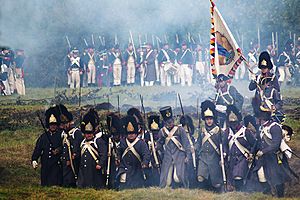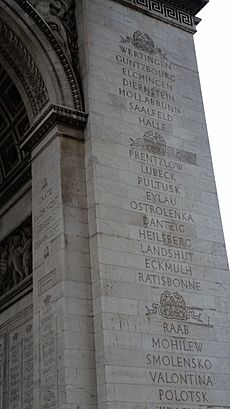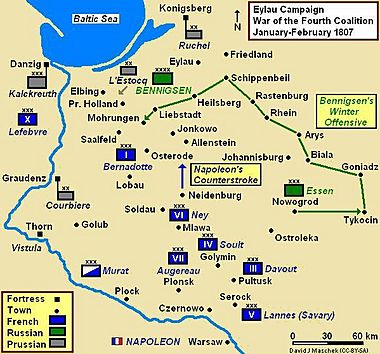Battle of Ostrołęka (1807) facts for kids
Quick facts for kids Battle of Ostrołęka (1807) |
|||||||
|---|---|---|---|---|---|---|---|
| Part of the War of the Fourth Coalition | |||||||
 Re-enactors at the Battle of Ostrołęka |
|||||||
|
|||||||
| Belligerents | |||||||
| Commanders and leaders | |||||||
| Strength | |||||||
| 20,000 | 25,000 | ||||||
| Casualties and losses | |||||||
| 60 dead (including 1 general), 400-500 wounded total: 1,200 |
1,300 dead (including 2 generals), 1,200 wounded (including 3 generals), 7 cannons captured total: 2,500 |
||||||
The Battle of Ostrołęka was a major fight on February 16, 1807. It happened between the French army, led by General Anne Jean Marie René Savary, and the Russian army, led by General Ivan Essen. The battle took place near Ostrołęka, a town that is now in Poland.
The French won this battle, forcing the Russian troops to retreat. This fight was part of the larger War of the Fourth Coalition, which was itself a part of the Napoleonic Wars. After the battle, the harsh winter weather made both armies stop fighting and settle into their winter camps.
What Led to the Battle?
See also: Battle of Mohrungen and Battle of Eylau
General Savary's French troops were positioned on the far right side of the main French army. Their job was to protect the routes leading to Warsaw and to cover the main army's rear.
In early February 1807, the French were pushed out of a town called Ostrów. Savary was then told to move his troops back to Ostrołęka. This move was to make sure his forces could easily connect with the main army.
Meanwhile, the Russian General Essen was ordered by his commander, Bennigsen, to attack Savary. Essen had about 25,000 soldiers. On February 15, he advanced towards Ostrołęka along both sides of the Narew River. Savary decided to defend Ostrołęka. He placed three brigades on low hills outside the town, supported by cannons across the river. He planned to attack the Russian forces on the right bank of the river the next morning.
How the Battle Unfolded

On the morning of February 16, French General Honoré Théodore Maxime Gazan arrived with some of his soldiers. At 9 AM, he found the enemy on the road to Nowogród and attacked them, making them run away. At the same time, the Russians attacked Ostrołęka from the left side of the river.
General François Frédéric Campana and General François Amable Ruffin defended the town with their brigades. Savary sent his chief of staff, General Honoré Charles Reille, to help. Russian soldiers tried to enter the city in many groups. The French let them come halfway into the streets before charging them. This resulted in many Russian soldiers being killed in the streets. The Russians then left the town and took positions behind the sand hills nearby.
By midday, more French troops arrived, led by General Nicolas Charles Oudinot and General Louis Gabriel Suchet. Oudinot led the left side of the French attack, while Suchet led the center. Reille commanded the right side. The French used all their cannons and marched towards the enemy. Oudinot led a successful charge with his cavalry (soldiers on horseback), defeating the Russian cossacks at the back of their army. The fighting was intense, but the Russians began to retreat and were chased for several miles.
What Happened After the Battle?
The French continued to chase the retreating Russians for several miles the next day. The battle was a clear victory for the French. Two Russian generals and many other officers were killed, and three Russian generals were wounded.
The Russians lost about 1,300 soldiers killed and 1,200 wounded. The French also captured 7 cannons and 2 flags from the Russians. The French had much fewer losses, with only 60 soldiers killed and about 400 to 500 wounded. Among the French killed was General Campana, whose death saddened Napoleon greatly.
Savary's victory at Ostrołęka showed Napoleon that the Russians were not very strong in that area. This meant Napoleon didn't have to worry much about his supply lines to Warsaw.
As a reward for his bravery, General Oudinot was made a Count and received a large sum of money. Savary was also honored with the Légion d'honneur, a very important French award.
After the battle, Napoleon ordered his 5th Corps to settle into winter camps. The weather was terrible due to a thaw, which made further fighting impossible. The Russians had left their winter camps first, and they ended up regretting it because of their defeat.
The Battle of Ostrołęka is remembered in France. It is mentioned at the galerie des batailles (Gallery of Battles) in Versailles and on the famous Arc de Triomphe in Paris. It is also an honor for several French army regiments.


